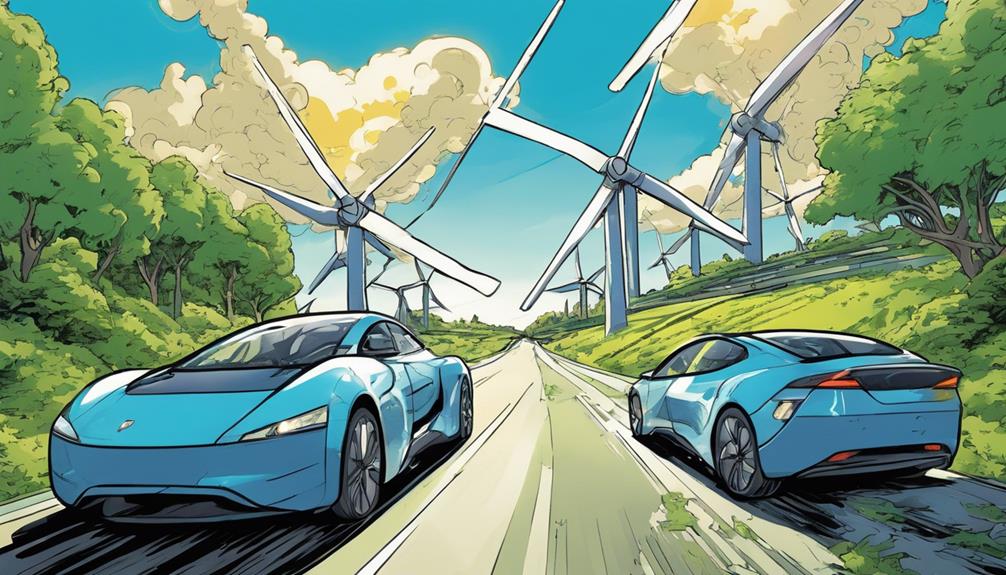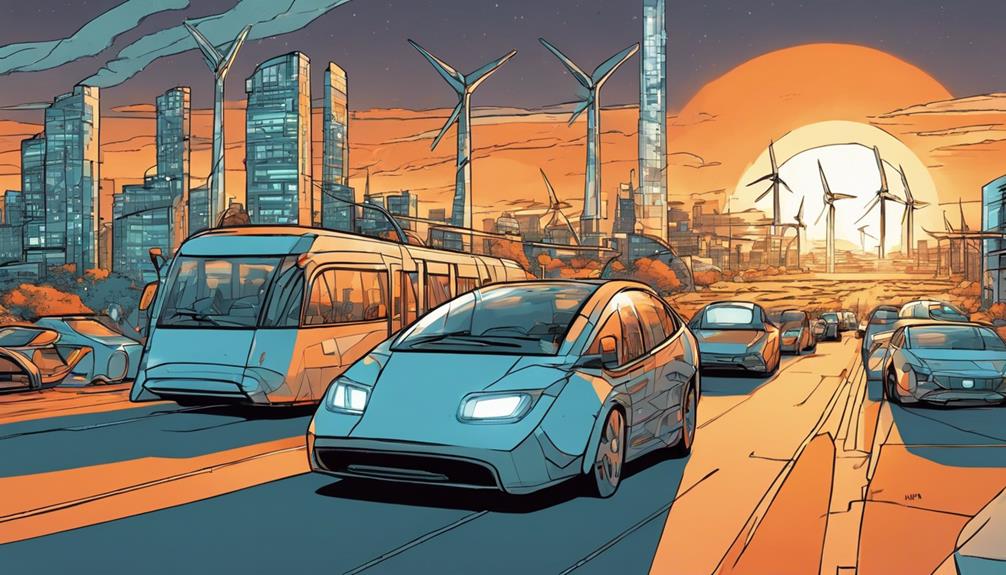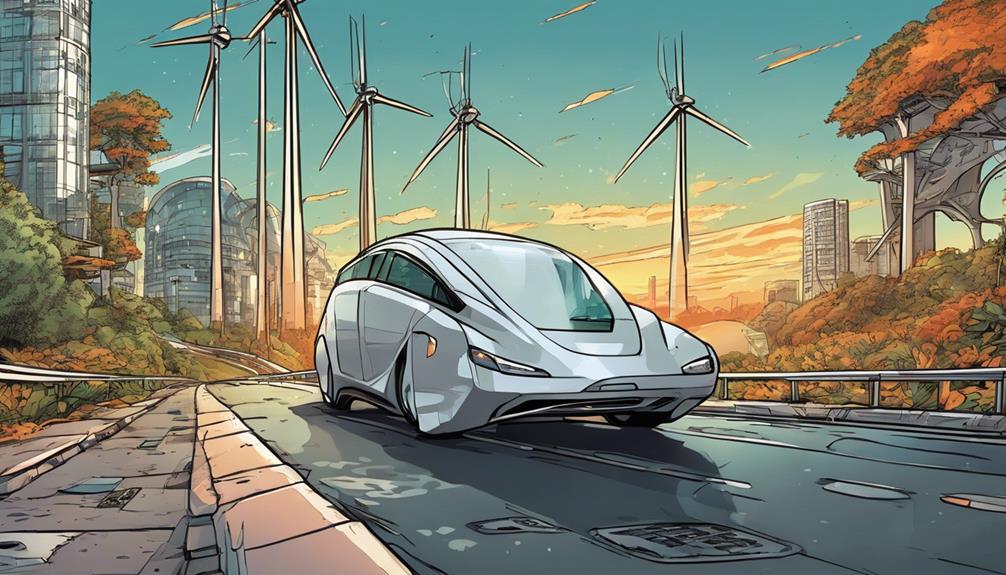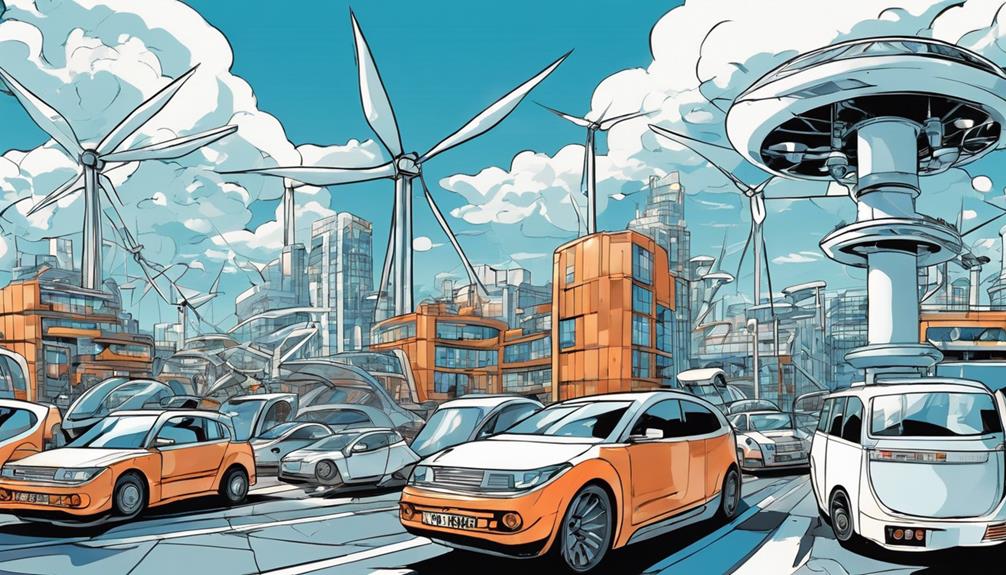As you explore the future of transportation, you're likely to find that solar energy is playing an increasingly crucial role in reducing our reliance on fossil fuels and mitigating the environmental impact of our daily commutes. Solar power reduces carbon footprint, offers cost savings, and extends vehicle range, making it an attractive solution for sustainable transportation. With advancements in solar panel efficiency and battery storage, solar-powered electric vehicles are becoming a viable alternative. You'll discover that despite the challenges, innovative solutions and government initiatives are paving the way for a solar-powered transportation revolution that could change the way you travel.
Key Takeaways
- Solar energy reduces carbon footprint in transportation by powering electric vehicles and extending their range with onboard solar panels.
- Solar-powered charging stations support infrastructure development, reducing emissions and dependence on fossil fuels.
- Advancements in solar panel efficiency and battery storage drive the adoption of solar-powered electric vehicles for sustainable transportation.
- Incorporating solar panels into electric vehicles provides a cleaner and quieter transportation experience while reducing emissions and fossil fuel dependence.
- Government initiatives and innovations in solar cell technology will promote the widespread adoption of solar-powered transportation by 2050.
Advancing Sustainable Transportation
As the transportation sector continues to be a significant contributor to greenhouse gas emissions, funding from the Bipartisan Infrastructure Law is now supporting sustainable transportation initiatives across the United States, paving the way for a cleaner future.
You're likely wondering what this means for you and the environment. Fundamentally, it's about reducing emissions from fossil fuels and shifting towards sustainable energy sources like solar power. The Energy Efficiency and Renewable Energy (EERE) office is at the forefront of this effort, focusing on advancing energy-efficient mobility systems to minimize emissions.
You'll be excited to know that EERE offers funding opportunities for clean energy research and development projects, which can lead to innovative solar-powered vehicles and infrastructure development. By collaborating with other agencies, the U.S. National Blueprint aims to decarbonize transportation by 2050 through various strategies and technologies.
As you can see, sustainable transportation is gaining momentum, and you're an indispensable part of this journey towards a cleaner, healthier environment.
Solar Energy in Transportation

As you explore the role of solar energy in transportation, you'll discover the significance of integrating solar power into your daily commute.
You'll learn how solar energy benefits the environment and your wallet by reducing greenhouse gas emissions and operating costs.
Now, let's examine the key aspects of solar power integration and the advantages it brings to the table.
Solar Power Integration
You can greatly reduce your carbon footprint by integrating solar power into your transportation, effectively turning your vehicle into a mobile solar panel that fuels itself. This innovative approach involves using solar energy to fuel electric vehicles and power public transportation systems.
By integrating solar panels into your vehicle, you can extend its range, reduce recharging needs, and lower your carbon footprint. Solar energy in transportation offers significant environmental benefits, reducing greenhouse gas emissions and dependence on fossil fuels.
Solar-powered charging stations play an essential role in supporting the growth of solar-powered transportation infrastructure. As technology advances, improvements in solar panel efficiency and battery storage systems are driving the adoption of solar energy in transportation.
Solar Energy Benefits
By harnessing the power of solar energy in transportation, individuals can greatly reduce their carbon footprint and contribute to a more sustainable future. One of the most significant solar energy benefits is the reduction of carbon emissions, which is pivotal for mitigating climate change.
By supporting solar-powered vehicles and public transit systems, you'll be promoting sustainable transportation options that produce zero emissions, improving air quality, and reducing dependence on non-renewable sources. Solar panels integrated into vehicles also enhance energy efficiency, extending their range and decreasing the need for frequent recharging.
As solar energy infrastructure develops in transportation networks, you'll see a significant reduction in carbon emissions and reliance on fossil fuels. By choosing solar-powered transportation options, you'll be contributing to a cleaner, healthier environment.
Sustainable Fuels and Batteries

Sustainable fuels like biodiesel, electricity, and hydrogen are revolutionizing the transportation sector, offering a cleaner, more environmentally friendly alternative to traditional fossil fuels.
As you explore solar energy in transportation, you'll find that these alternative fuels play a pivotal role in reducing dependence on fossil fuels and conserving traditional fuel resources.
The adoption of solar-powered transportation is gaining momentum, and advances in battery technology are making it more efficient. The U.S. Department of Energy's EERE is working to improve electric vehicle batteries, enhancing energy efficiency and driving range.
With sustainable energy sources like solar-powered charging stations, you can reduce carbon emissions and enjoy energy independence.
Stay informed with clean energy news to keep up with the latest advancements in sustainable fuels and batteries for transportation. By embracing these innovations, you'll be contributing to a cleaner, greener future for generations to come.
Solar-Powered Electric Vehicles

As electric vehicles (EVs) continue to gain traction, integrating solar energy into their design is becoming an increasingly viable solution to extend their range and reduce recharging needs.
You'll soon see solar-powered electric vehicles, including buses and trains, hitting the roads and tracks. These vehicles will harness energy from the sun to power their motors, reducing emissions and dependence on fossil fuels.
By incorporating solar panels, you'll reduce your carbon footprint and reliance on non-renewable energy sources. Imagine pulling into a charging station that uses solar energy to top up your battery – it's an environmentally friendly transportation dream come true!
The benefits of sustainable transportation are clear: with solar-powered EVs, you'll reduce your impact on the environment while enjoying a smoother, quieter ride. As you cruise around, you'll be powered by clean energy from the sun, not dirty fossil fuels.
It's time to shift gears and accelerate towards a sustainable transportation future.
Challenges in Solar Transportation

As you explore the potential of solar-powered transportation, you'll soon realize that there are several challenges that need addressing.
You'll encounter limitations in solar energy generation, which affects the range and charging capabilities of these vehicles.
You'll also have to take into account how weather conditions impact the efficiency of solar-powered transportation, making it essential to examine these challenges closely.
Solar Energy Limitations
While you may be excited about the prospect of solar-powered transportation, you'll quickly realize that limited range is a significant hurdle due to the current constraints of battery technology. This limitation is a major solar energy limitation, making it difficult for vehicles to travel long distances without recharging.
Furthermore, the high upfront costs of solar-powered vehicles make them less accessible to the masses, limiting their widespread adoption.
Another major challenge is infrastructure limitations. The lack of supporting infrastructure, such as charging stations, hinders the growth of solar-powered transportation. Additionally, solar-powered vehicles may not perform as well as traditional vehicles in certain weather conditions, such as extreme weather conditions or limited sunlight. This impacts their overall performance and reliability.
These solar energy limitations highlight the need for further research and development to overcome these challenges and make solar-powered transportation a viable option for the future.
Range and Charging Issues
You're likely wondering how solar-powered vehicles can overcome the limitations of battery technology to achieve a decent range and reliable charging, given the importance of these factors in widespread adoption. The reality is that current solar-powered electric vehicles face challenges with limited range due to battery technology constraints. This restriction impacts their charging capabilities, making it difficult for them to become a viable option for widespread adoption.
Here are some key challenges to take into account:
- Range limitations: Current battery technology can't support long-distance travel, making solar-powered vehicles less practical for road trips.
- Infrastructure limitations: The absence of solar charging stations hinders the adoption of solar-powered vehicles, as owners have limited options for recharging.
- Upfront costs: Integrating solar technology into transportation systems comes with high initial costs, making it difficult for consumers to invest in solar-powered vehicles.
- Adoption challenges: Addressing range and charging issues is essential for advancing solar-powered transportation as a sustainable option, but it's a complex problem to solve.
To overcome these challenges, innovators must focus on developing more efficient battery technology, expanding infrastructure for solar charging stations, and reducing initial costs for integrating solar technology into transportation systems.
Weather Dependence Challenges
As you explore the potential of solar energy in transportation, you'll encounter a substantial obstacle: weather reliance. Solar-powered transportation faces a significant barrier in its dependency on favorable weather conditions, which can greatly impact its performance and range.
The efficiency of solar panels on vehicles is directly impacted by weather fluctuations, reducing energy generation on cloudy or rainy days. This, in turn, affects the operation of solar-powered transportation, limiting its dependability. The amount of sunlight available for energy conversion is essential, and weather conditions can greatly diminish it.
However, you're not alone in this challenge. Innovative solutions like energy storage systems can help mitigate the impact of weather reliance on solar-powered transportation. By incorporating these systems, you can guarantee a steady supply of energy, even on less-than-ideal days.
Addressing weather reliance challenges is vital for the widespread adoption and reliability of solar energy in transportation systems. By finding ways to overcome this hurdle, you can unleash the full potential of solar-powered transportation and pave the way for a more sustainable future.
Future of Solar Transportation

By 2050, experts predict that solar-powered vehicles will dominate the transportation sector, revolutionizing the way you travel and reducing carbon emissions notably. As you imagine a future with sustainable transportation, here are some exciting developments to look forward to:
- Increased adoption of solar-powered systems to power electric vehicles, reducing dependence on fossil fuels and emissions.
- Advancements in solar cell technology, making them more efficient and cost-effective for widespread use.
- Government initiatives and investments in solar energy to promote economic growth, job creation, and environmental benefits.
- Innovations in air transport, such as solar-powered planes and drones, for a more sustainable future.
As solar energy integration in the transportation sector grows, you can expect to see a noticeable reduction in emissions and operating costs. The benefits of sustainable transportation will become a reality, with solar-powered vehicles leading the way. With continued advancements in technology and government support, the future of solar transportation looks bright, and you can be part of the movement towards a cleaner, greener tomorrow.
Frequently Asked Questions
How Does Solar Energy Affect Transportation?
You're wondering how energy affects transportation, and the answer is, it makes a huge impact! In the context of solar energy, you'll find it powers electric vehicles, reduces emissions, and saves you money, making transportation cleaner and more efficient overall.
How Does Solar Energy Contribute to Sustainability?
You're wondering how solar energy contributes to sustainability. In general, it reduces reliance on finite resources, decreases pollution, and promotes eco-friendly practices. In the context of transportation, solar energy powers electric vehicles, extending their range and reducing emissions.
What Does the Future Hold for Solar-Powered Transportation?
You're wondering what the future holds for transportation, and it's exciting! With tech advancements, you'll see more eco-friendly vehicles, reduced emissions, and innovative modes of transport, changing the game for a cleaner, more sustainable tomorrow.
What Is the Most Sustainable Transportation?
You're "on the right track" when considering the most sustainable transportation – it's not a one-size-fits-all answer, but a combination of options like walking, biking, and public transit that prioritize reducing carbon emissions and promoting energy efficiency.
Conclusion
You've finally reached the finish line of this solar-powered journey, and what do you get? A reality check that we're still stuck in traffic, burning fossil fuels, and contributing to climate change.
The irony isn't lost on us – despite the promising advancements in solar energy and sustainable transportation, we're still far from trading in our gas-guzzlers for sun-kissed EVs.
But hey, at least we can dream of a sunny future, right?










